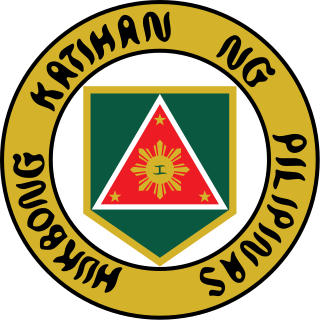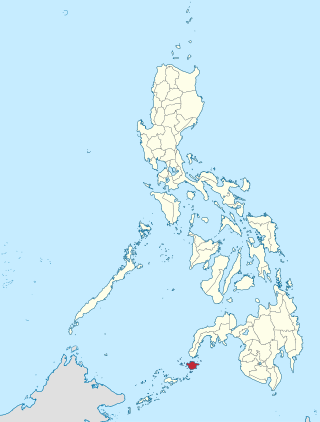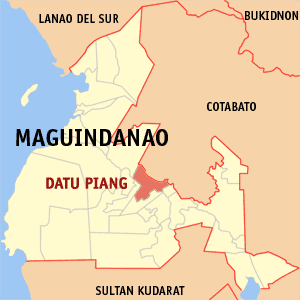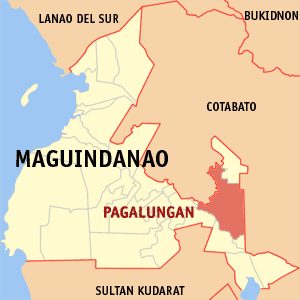
The Moro Islamic Liberation Front is a group based in Mindanao seeking an autonomous region of the Moro people from the central government. The group has a presence in the Bangsamoro region of Mindanao, the Sulu Archipelago, Palawan, Basilan, and other neighbouring islands. The armed wing of the group was the Bangsamoro Islamic Armed Forces (BIAF), although the name of its parent organization, the MILF, was often used to refer to the BIAF. In July, 2018, the Philippine government passed the Bangsamoro Organic Law, giving more autonomy to Muslims. In return, MILF announced that it would disarm its 30,000 fighters.

The Moro people or Bangsamoro people are the 13 Muslim-majority ethnolinguistic Austronesian groups of Mindanao, Sulu, and Palawan, native to the region known as the Bangsamoro. As Muslim-majority ethnic groups, they form the largest non-Christian population in the Philippines, and comprise about 5% of the country's total population, or 5 million people.

The Moro conflict was an insurgency in the Mindanao region of the Philippines, which has involved multiple armed groups, and has been ongoing since March 1968. Peace deals have been signed between the Philippine government and two major armed groups, the Moro National Liberation Front (MNLF) and the Moro Islamic Liberation Front (MILF), but other smaller armed groups continue to exist. In 2017, the peace council settled around 138 clan conflicts.

The Philippine Army (PA) is the main, oldest and largest branch of the Armed Forces of the Philippines (AFP), responsible for ground warfare and as of 2021 had an estimated strength of 101,000 soldiers backed by 100,000 ready reserves. The service branch was established on December 21, 1935, as the Philippine Commonwealth Army. The Philippine Army has engaged in many conflicts including the ongoing Communist rebellion in the Philippines, the Moro conflict and, alongside other national military forces, in conflicts of international scope.

The 2007 Basilan beheading incident was an armed incident in July 2007 between the Moro Islamic Liberation Front (MILF) rebels and the Philippine Army which led to the execution of 14 or 23 members of the Philippine Marines, amongst them 11 beheaded in the province of Basilan in the southern Philippines.

Cardozo Manalo Luna is a retired three-star general and the 35th Vice Chief of Staff of the Armed Forces of the Philippines. Cardozo Luna also served as the commander of two unified commands, Eastern Mindanao Command and Central Command. He served as the Philippine Ambassador to The Hague, Netherlands from 2009 until 2010 He is the current Undersecretary of Department of National Defense.
The 2008 Battle of North Cotabato was a military confrontation between the Armed Forces of the Philippines and a rogue Moro Islamic Liberation Front (MILF) faction under the command of Umbra Kato in North Cotabato, a province of Mindanao, in the Philippines.

The 8th Infantry Division, Philippine Army, known officially as the Storm Trooper Division, is one of the Philippine Army's Infantry units in the Visayas and under the AFP Central Command, combating local communist insurgent units, and terrorists.
The 104th Infantry Brigade, 1st Infantry Division, Philippine Army, known officially as the Sultan Brigade, is one of the brigades of the Philippine Army which is organic to its 1st Infantry Division. It is an infantry unit, and specializes in anti-guerrilla warfare.
In the late 1960s, an independence movement was founded in Mindanao, the Philippines to separate the Muslim majority-Moro areas from the rest of the Philippines.
Operation Darkhorse was an offensive against the Bangsamoro Islamic Freedom Fighters (BIFF) launched by the Armed Forces of the Philippines on January 27, 2014.

The Comprehensive Agreement on Bangsamoro (CAB) is a final peace agreement signed between the Government of the Philippines and the Moro Islamic Liberation Front on March 27, 2014 at the Malacañang Palace in Manila. Under the agreement, the Islamic separatists would turn over their firearms to a third party, which would be selected by the rebels and the Philippine government. The MILF agreed to decommission its armed wing, the Bangsamoro Islamic Armed Forces (BIAF). In return, the government would establish an autonomous Bangsamoro. Power sharing was a central point to the autonomy redesign.

The 1976 Tripoli Agreement was signed on December 23, 1976 in Tripoli, Libya by Carmelo Z. Barbero, representing the Government of the Philippines and Nur Misuari of the Moro National Liberation Front. The agreement defined autonomous administrative divisions for Muslims in the southern Philippines, the establishment of an autonomous government, judicial system for Sharia law and special security forces, and the observance of a ceasefire. The autonomous region was to have its own economic system, including an Islamic bank.

The Battle of Camp Abubakar, codenamed Operation Terminal Velocity, was the final phase of the 2000 Philippine campaign against the Moro Islamic Liberation Front which resulted in the capture of Camp Abubakar al Siddique, stronghold of the Moro Islamic Liberation Front and its largest settlement, and seat of its Shariah-based government.

The 2000 Philippine campaign against the Moro Islamic Liberation Front was a military campaign conducted by the Armed Forces of the Philippines (AFP) against a Muslim secessionist group that took place during the presidency of Joseph Estrada in the Autonomous Region in Muslim Mindanao in the Philippines. The campaign was waged "to weaken the Moro Islamic Liberation Front's capability to undermine the territorial integrity of the Philippines and inflict harm on both government personnel and civilians".
Camp Iranun is a Philippine Army military base located in Barira, Maguindanao, Philippines. It is named after the Iranun people, a Moro ethnic group native to the area encompassing the boundaries of Maguindanao, Lanao del Sur and North Cotabato provinces.

Operation Valiancy was the initial military operation of the 2000 Philippine campaign against the Moro Islamic Liberation Front which took place in Maguindanao, Philippines. The Philippine Army, primarily units of its 6th Infantry Division, assaulted Moro Islamic Liberation Front forces in the Talayan-Shariff Aguak-Datu Piang area of Maguindanao and captured Camp Omar ibn al-Khattab, its third largest camp located there. Camp Omar, named after Umar, a senior Sahabi of the Islamic prophet Muhammad, served as the headquarters of the 206th BIAF brigade under Ameril Umbra Kato and was defended by 500 guerillas. Camp Jabal Uhob, another MILF camp in the area, was also captured. Planned to be a week-long operation, Valiancy took only two days to realize its objectives.

The Battle of the Buliok Complex took place on 11 February 2003 in an area within the provinces of Maguindanao and Cotabato in Mindanao, Philippines. The 60-hectare complex, which stretches from Pikit, Cotabato to Pagalungan, Maguindanao, was a stronghold of the Muslim separatist Moro Islamic Liberation Front (MILF). Accused by the Philippine government of harboring members of Pentagon, a notorious kidnap-for-ransom gang operating in Mindanao, the MILF was attacked in the Buliok complex by the Armed Forces of the Philippines under orders from then-President Gloria Macapagal Arroyo.
Dickson Peñas Hermoso is a Filipino government official and former military official who serves as the head of the Ministry of Transportation and Communications of Bangsamoro. He was also known for being part of the Philippine Army's 6th Infantry Division which was involved in the Moro conflict.
On November 8, 2022, the Philippine Army and the Moro Islamic Liberation Front (MILF) engaged in a gunfight in Ungkaya Pukan, Basilan, while the army was conducting clearing operations on "lawless elements" allegedly taking refuge in the territory controlled by the MILF. Fighting between the two sides continued until November 10, 2022 when a ceasefire between two sides were signed.













